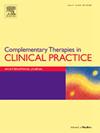在马辅助治疗中,客户、治疗马和治疗师的心率和唾液皮质醇作为觉醒和同步的指标。
IF 2.2
3区 医学
Q2 INTEGRATIVE & COMPLEMENTARY MEDICINE
引用次数: 0
摘要
背景:本探索性研究旨在分析马辅助治疗(EAT)中来访者、治疗马和治疗师之间的生理相互作用过程。方法:我们测量了一名治疗师、四匹治疗马和10名初成年女性来访者(Mn = 21.8岁,SD = 3.39)在标准化治疗前、治疗期间和治疗后的心率(HR)、心率变异性(HRV)和皮质醇水平。患者被诊断为轻度(N = 5)至中度(N = 5)智力障碍(ID)。结果:在EAT疗程中,患者的HR、HRV和皮质醇水平没有显著变化。除了在EAT方案的挑战阶段,在与治疗马互动时,客户的HR明显较低,没有观察到有治疗马或没有治疗马的治疗阶段之间的差异。治疗师与来访者之间、治疗师与马之间的HR显著相关。当治疗师与一匹熟悉的马互动时,这种效果更大。客户和马的人力资源回报率也相关,但只有当这匹马是客户熟悉和喜欢的马时才相关。结论:这些结果表明,关系强度是影响同步过程的重要因素。此外,在治疗环境中纳入马可以导致智力残疾的年轻成年人在掌握挑战时降低HR。未来的研究应该调查EAT的潜在益处,考虑到相互影响以及来访者、治疗师和马之间的关系。本文章由计算机程序翻译,如有差异,请以英文原文为准。
Heart rate and salivary cortisol as indicators of arousal and synchrony in clients, therapy horses and therapist in equine-assisted therapy
Background
This exploratory study aimed to analyse physiological interaction processes in equine-assisted-therapy (EAT) between client, therapy horse and therapist.
Methods
We measured heart rate (HR), heart rate variability (HRV) and cortisol levels before, during and after a standardized therapy session and a control condition in one therapist, four therapy horses and ten female clients in emerging adulthood (Mn = 21.8 years, SD = 3.39). The clients were diagnosed with mild (N = 5) to moderate (N = 5) intellectual disability (ID).
Results
There was no significant change in the client's HR, HRV and cortisol levels during an EAT session. No difference was observed between therapy sessions with or without a therapy horse, except during the challenge phase of the EAT protocol, where clients had a significantly lower HR when interacting with the therapy horse. HR between therapist and client correlated significantly, as well as between therapist and horse. This effect was greater when therapists interacted with a familiar horse. Clients' and horses' HRs also correlated, but only when the horse was the clients' familiar and preferred horse.
Conclusions
These results indicate that relationship intensity is an important factor for the synchronization process. Moreover, the inclusion of horses in a therapeutic setting can lead to a decreased HR in young adults with intellectual disability while mastering a challenge. Future research should investigate this potential benefit of EAT, considering the reciprocal influences and the relationship between client, therapist and horse.
求助全文
通过发布文献求助,成功后即可免费获取论文全文。
去求助
来源期刊

Complementary Therapies in Clinical Practice
INTEGRATIVE & COMPLEMENTARY MEDICINE-
CiteScore
6.30
自引率
6.70%
发文量
157
审稿时长
40 days
期刊介绍:
Complementary Therapies in Clinical Practice is an internationally refereed journal published to meet the broad ranging needs of the healthcare profession in the effective and professional integration of complementary therapies within clinical practice.
Complementary Therapies in Clinical Practice aims to provide rigorous peer reviewed papers addressing research, implementation of complementary therapies (CTs) in the clinical setting, legal and ethical concerns, evaluative accounts of therapy in practice, philosophical analysis of emergent social trends in CTs, excellence in clinical judgement, best practice, problem management, therapy information, policy development and management of change in order to promote safe and efficacious clinical practice.
Complementary Therapies in Clinical Practice welcomes and considers accounts of reflective practice.
 求助内容:
求助内容: 应助结果提醒方式:
应助结果提醒方式:


